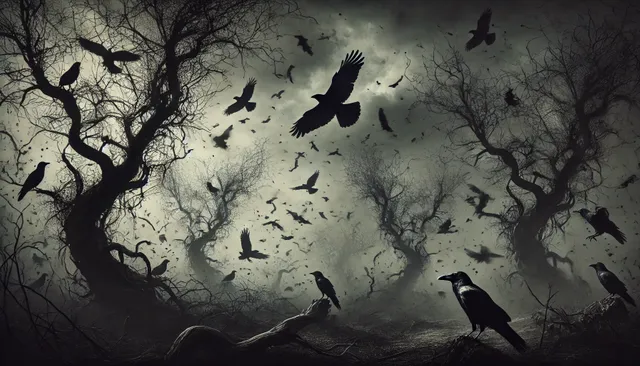Why Crows Are Considered Bad Luck in European Folklore 🦅

Crows and ravens, often seen as harbingers of bad luck or omens of death, hold a complex place in European folklore. Their dark plumage, eerie calls, and association with death and the supernatural have contributed to their ominous reputation. Let's delve into the reasons why crows are considered bad luck in European culture.
Symbolism in Mythology and Folklore 📜
Association with Death and the Afterlife
Norse Mythology: In Norse mythology, the god Odin had two ravens, Huginn and Muninn, who flew across the world to bring back information. Despite their helpful role, ravens were often associated with battlefields and death, observing the fallen warriors.
Celtic Folklore: The Celts believed that crows and ravens were connected to the Morrígan, a goddess associated with war and death. The sight of a crow was often interpreted as a sign of impending death or disaster.
Christian Symbolism
Biblical References: In the Bible, ravens are mentioned several times, often with negative connotations. For instance, Noah sent out a raven before the dove to check if the floodwaters had receded, but the raven did not return. This has been interpreted as a symbol of uncleanliness and bad omens.
Medieval Europe: During the medieval period, crows were often seen as witches' familiars or servants of the devil. Their presence was thought to indicate witchcraft or impending doom.
Folklore and Superstition 🧙♂️
Omens and Superstitions
Bringers of Bad News: In many European cultures, seeing a single crow was considered an omen of bad news. A crow cawing near a house was believed to predict the death of a family member.
Counting Crows: A common superstition involves counting the number of crows seen to predict one's fortune. For example:
- One crow for sorrow,
- Two crows for joy,
- Three crows for a girl,
- Four crows for a boy,
- Five crows for silver,
- Six crows for gold,
- Seven crows for a secret never to be told.
This rhyme highlights how seeing a single crow was particularly ominous.
Literary and Cultural Depictions
Edgar Allan Poe's "The Raven": The famous poem by Edgar Allan Poe, "The Raven," cemented the bird's association with melancholy and misfortune in Western literature. The raven in the poem symbolizes sorrow, loss, and the haunting presence of death.
Shakespearean Tragedies: In Shakespeare's works, crows and ravens are often used as symbols of foreboding and doom. For instance, in "Macbeth," the raven is mentioned as a bird of ill omen that heralds Duncan's death.
Psychological Impact 🌑
Appearance and Behavior
Dark Plumage: The crow's black feathers are often associated with the unknown and the mysterious, evoking fear and superstition.
Eerie Calls: The crow's cawing is harsh and unsettling, contributing to its image as a bird of ill omen. The sound is often interpreted as a warning or a harbinger of bad events.
Conclusion 🌌
The belief that crows are bad luck in European folklore is deeply rooted in their association with death, the supernatural, and ominous omens. From mythology and religious symbolism to literature and superstitions, crows have been portrayed as harbingers of doom and misfortune. Despite these dark associations, crows are also intelligent and fascinating creatures that play a crucial role in the natural world.
Sources: